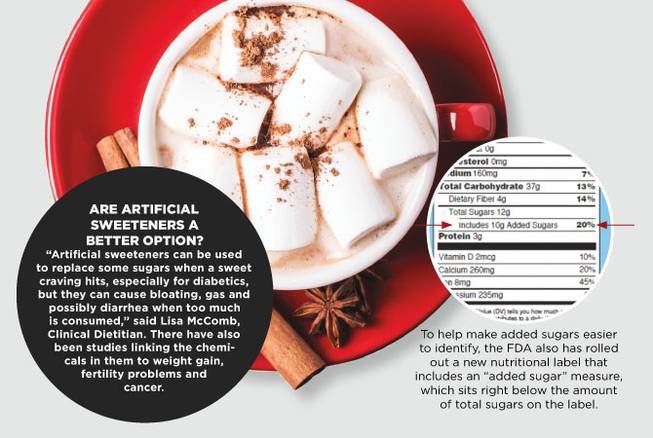
Monday, Oct. 31, 2016 | 2 a.m.
There’s been a lot of buzz about sugar and its negative effects on the body. High sugar intake is associated with obesity, diabetes and cardiovascular disease, among other ailments, and its impact has left doctors, researchers and public health officials with a bad taste in their mouths.
“Our bodies need sugar to thrive, but in moderate amounts. Sugar can have a very negative effect if consumed in excess,” said Lisa McComb, RD, LD, IBCLC, Clinical Dietitian at Sunrise Hospital and Medical Center. While cutting out sugar entirely is not a healthy or realistic solution, limiting certain types of sugar intake and maintaining a balanced diet are integral to good health.
How much sugar is too much?
This is a topic of some debate, and unfortunately, there is no formula to dictate how much sugar each of us should consume. However, looking at the type of sugar in any given food is a good place to start.
“Aiming for natural foods, like fruits and vegetables, versus processed foods can help some. The sugar in natural foods is what’s supposed to be there, rather than sugar that has been added for flavor,” McComb said. In general, sugars that occur naturally in fruits and vegetables are easier for the body to digest and cause less extreme spikes in blood-sugar level, which is associated with weight gain and diabetes.
For example, the sugar in fruit is called fructose. While some fruits have high fructose levels, they’re also rich in fiber, which slows the absorption of the sugar through the liver and into the bloodstream. A candy bar, on the other hand, may have comparable amounts of sugar, but it’s a different type of sugar and hits the bloodstream faster and more aggressively.
The new U.S. Food and Drug Administration guidelines for sugar consumption recommend that people consume no more than 10 percent of their daily calories from added sugar, which is 25 grams of sugar based on a 2,000-calorie-a-day diet. This does not include natural sugars, such as those found in fruit, or carbohydrates — it simply speaks to the amount of sugar added to foods. Sugar can go by many names, and identifying added sugar, or “hidden” sugar, can be difficult.
Nutritional labels and ingredient lists
To help make added sugars easier to identify, the FDA also has rolled out a new nutritional label that includes an “added sugar” measure, which sits right below the amount of total sugars on the label. This means consumers will be able to see, for example, that of the 48 grams of total sugar in a serving, 35 grams were added.
Manufacturers will have until July 26, 2018, to make these changes on their labels. Until then, it’s important to be able to recognize added sugar on the ingredient list.
There are approximately 60 terms for added sugar. “The easiest way to look for sugar on a label is to find anything that ends in –ose,” McComb said. This includes fructose, galactose, lactose, maltose and sucrose.
Anything qualified as a syrup is also sugar. Common syrups you’ll see on a label are corn syrup, corn syrup solids, high fructose corn syrup, rice syrup, sorghum syrup and tapioca syrup.
Also indicating added sugar are terms or words using “malt,” such as barley malt, ethyl maltol, malt syrup, maltodextrin and maltose.
Health conditions caused by high sugar intake
The Obesity Society reports that the amount of added sugar consumption in adults in the U.S. has increased by more than 30 percent in three decades. Added sugar, mentioned as a “non-nutritive calorie source,” jumped from 228 calories a day in 1977 to 300 calories in 2009-10. In children, it increased by 20 percent during the same time period.
While these numbers are concerning on their own, they account for only the average consumption in adults. The top 20 percent of adult consumers ate approximately 721 calories a day in added sugar. This high amount of non-nutritive calories leads to weight gain, which can advance to other medical conditions, according to McComb.
Other conditions affiliated with weight gain and high-sugar diets include diabetes, insulin resistance, obesity, liver failure, kidney disease, high blood pressure, heart disease, cognitive decline, nutritional deficiencies and gout.
Are artificial sweeteners a better option?
Artificial sweeteners are a popular alternative to traditional sweeteners, but they’re not without side effects.
“Artificial sweeteners can be used to replace some sugars when a sweet craving hits, especially for diabetics, but they can cause bloating, gas and possibly diarrhea when too much is consumed,” McComb said.
While artificial sweeteners may be a good, occasional substitute, there have been studies linking the chemicals in them to weight gain, fertility problems and cancer. As with sugar, moderation is key.

Join the Discussion:
Check this out for a full explanation of our conversion to the LiveFyre commenting system and instructions on how to sign up for an account.
Full comments policy